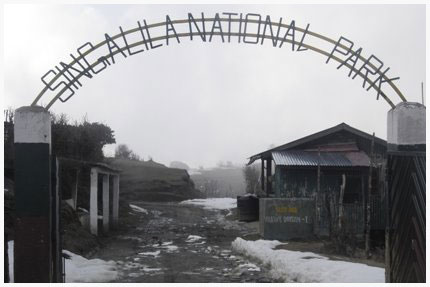
Singalila National Park is a reserved forest area located at the Singalila ridge in Darjeeling district. This is a high altitude park spanning between 7,900ft to about 12,000ft covering an area of 78.6 square kms. This is in fact the highest altitude park in the state of West Bengal.
It was initially a wild life sanctuary and later made into a national park in 1992. The whole of Singalila range and the national park has long been part of the trekking route to Sandakphu and Phalut.
Singalila national park has two ranges. The southern range starts shortly after Manebhanjan and extends through Tonglu, Tumling, Gairibas, Kalipokhari, Bikheybhanjan and all the way up to Sandakphu (11,909 ft) and beyond to Phalut (11,811 ft). Sandakphu and Phalut are the two highest peaks of Singalila range.
 For visits to the park, this route is most popular to tourists. There is also a gravel road for jeeps that goes through the park along this route up to Sandakphu and Phalut. The northern range of the park is accessible through Rimbik. To the north of the park is Sikkim and to its west is Nepal.
For visits to the park, this route is most popular to tourists. There is also a gravel road for jeeps that goes through the park along this route up to Sandakphu and Phalut. The northern range of the park is accessible through Rimbik. To the north of the park is Sikkim and to its west is Nepal.
Best time to visit Singalila Park
There are two great seasons to visit the park. One is during Spring (i.e. from March until May) when the flowers like rhododendrons and orchids bloom in full, and then again after the monsoon is over (i.e. between October and early December) when the snow peaks show in their dazzling beauty in a clear blue sky.
Note that the park is usually closed during the monsoon time (between mid June to Mid September). Even during April and October, there may be occasional showers. This entire stretch is notorious for unpredictable rains. So keep one or two days more for the visit than what may be required in an ideal case. This is to ensure that the rain doesn’t spoil the whole party. And for the same reason, carry a raincoat or umbrella.
From Tumling onwards, it can get very cold particularly during the winter. Even in April you may get snow in places like Sandakphu. So carry adequate woolens, caps and gloves. Always wear sturdy but comfortable pair of shoes.